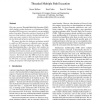Free Online Productivity Tools
i2Speak
i2Symbol
i2OCR
iTex2Img
iWeb2Print
iWeb2Shot
i2Type
iPdf2Split
iPdf2Merge
i2Bopomofo
i2Arabic
i2Style
i2Image
i2PDF
iLatex2Rtf
Sci2ools
ISCA
1998
IEEE
1998
IEEE
Threaded Multiple Path Execution
This paper presents Threaded Multi-Path Execution (TME), which exploits existing hardware on a Simultaneous Multithreading (SMT) processor to speculatively execute multiple paths of execution. When there are fewer threads in an SMT processor than hardware contexts, threaded multi-path execution uses spare contexts to fetch and execute code along the less likely path of hard-to-predict branches. This paper describes the hardware mechanisms needed to enable an SMT processor to efficiently spawn speculative threads for threaded multi-path execution. The Mapping Synchronization Bus is described, which enables the spawning of these multiple paths. Policies are examined for deciding which branches to fork, and for managing competition between primary and alternate path threads for critical resources. Our results show that TME increases the single program performance of an SMT with eight thread contexts by 14%-23% on average, depending on the misprediction penalty, for programs with a high m...
| Added | 05 Aug 2010 |
| Updated | 05 Aug 2010 |
| Type | Conference |
| Year | 1998 |
| Where | ISCA |
| Authors | Steven Wallace, Brad Calder, Dean M. Tullsen |
Comments (0)

